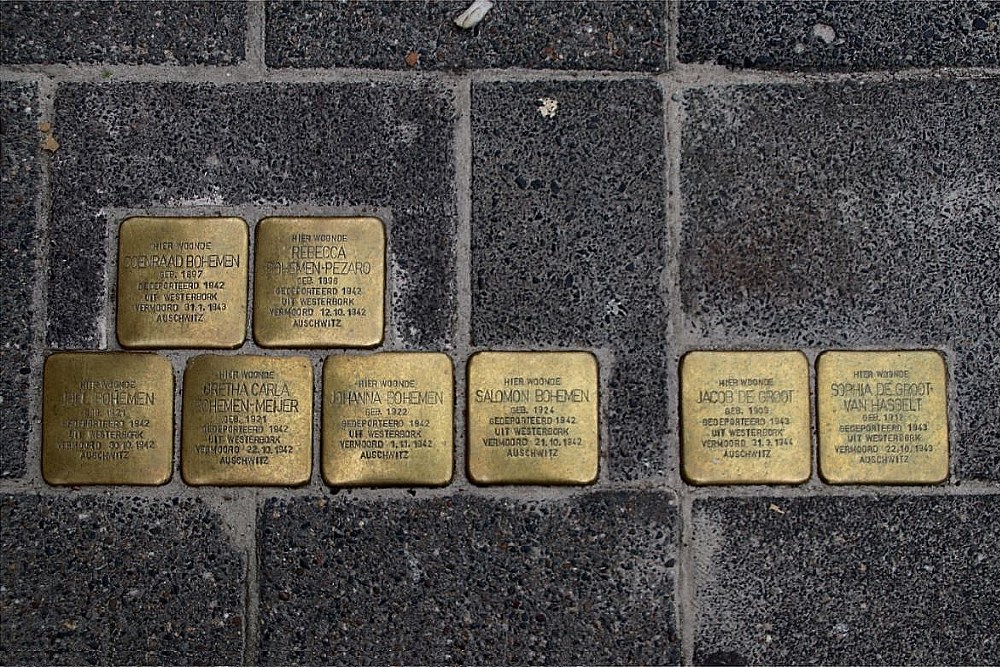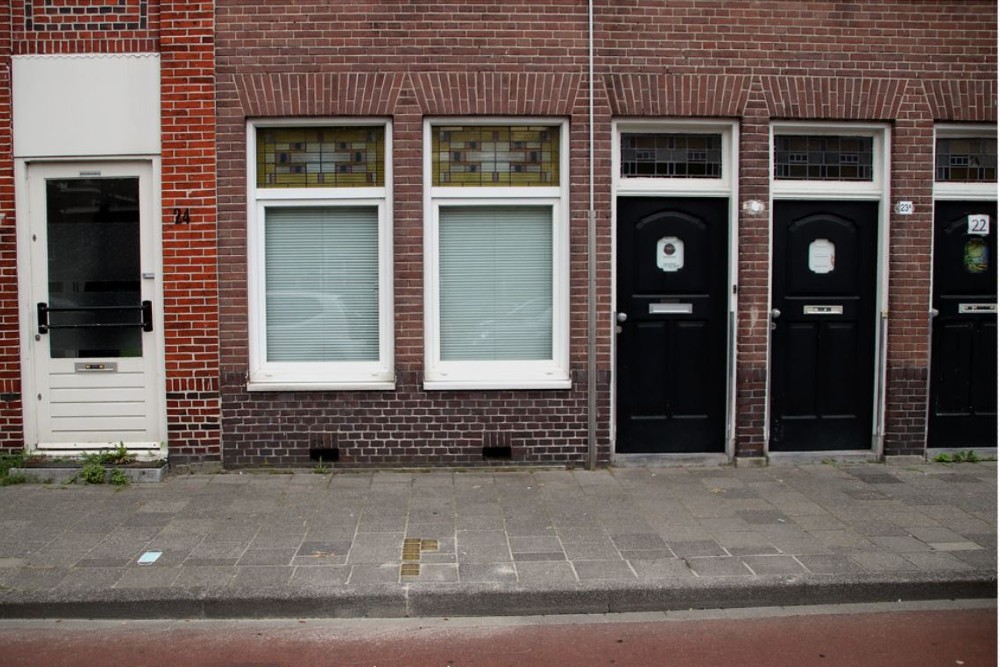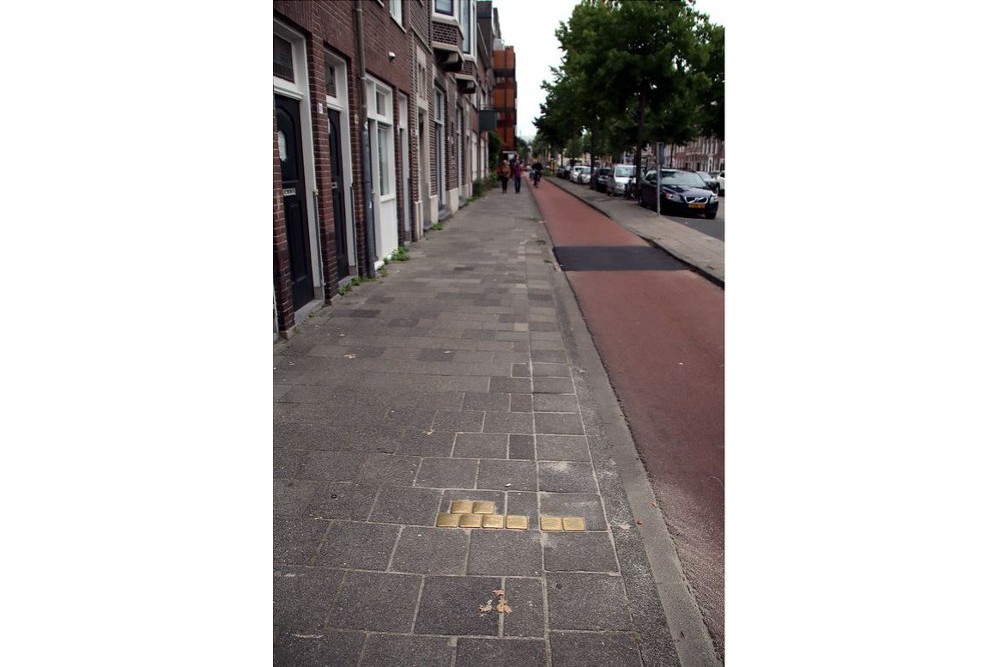Stumbling Stones Aweg 23a
These small, brass, memorial plaques (stolpersteine, struikelsteenen, or stumbling stones) commemorate:
* Coenraad Bohemen, born 1897, deported 1942 from Westerbork, murdered 31 January 1943, Auschwitz.
* Rebecca Bohemen-Pezaro, born 1896, deported 1942 from Westerbork, murdered 12 October 1942, Auschwitz.
* Joel Bohemen, born 1921, deported 1942 from Westerbork, murdered 30 October 1942, Auschwitz.
* Gretha Carla Bohemen-Meijer, born 1921, deported 1942 from Westerbork, murdered 22 October 1942, Auschwitz.
* Johanna Bohemen, born 1922, deported 1942 from Westerbork, murdered 1 November 1942, Auschwitz.
* Salomon Bohemen, born 1924, deported 1942 from Westerbork, murdered 21 October 1942, Auschwitz.
* Jacob de Groot, born 1909, deported 1943 from Westerbork, murdered 31 March 1944, Auschwitz.
* Sophia de Groot-van Hasselt, born 1912, deported 1943 from Westerbork, murdered 22 October 1943, Auschwitz.
Background
Coenraad Bohemen, a traveling sales representative, and Rebecca Pezaro married. Their three children were all born in Groningen in the early 1920s – Joël, Johanna, and Salomon. On 4 October 1942, all five were deported to Westerbork, then on 9 October they were deported onward to Auschwitz. Rebecca Bohemen-Pezaro was killed immediately; Coenraad Bohemen survived only another 3½ months.
Their son Joël Bohemen married Gretha Clara Meijer, a sales person, on 10 September 1942 in Groningen, and from then on they were registered with his parents at A-weg 23a. But according to Joods Monument, in June 1941, they lived in Groningen at Museumstraat 9a with her parents and siblings and husband Joël. Sources agree that on 4 October 1942, Joël, his parents, brother, and sister were deported to Westerbork, then to Auschwitz. Gretha, however, remained in Groningen until about 18 October, when she was taken to Westerbork (after the Bohemens had already been taken to Auschwitz). Gretha herself was quickly deported on to Auschwitz where she was killed on 22 October – the same date her mother and twin sister were killed there. There are inconsistencies in Joël’s Auschwitz date of death. Open Archives NL and Joods Monument state 31 January 1943. However, according to Stichting Schilderswijk Stolpersteine Groningen, the death certificate drawn up by the municipality incorrectly states that he died on January 31, 1943, and offers 30 October 1942 as the actual date of his death.
There is no indication that either of Joël’s siblings, Johanna or Salomon, married. Johanna was a hair cutter, but the occupation of the 18-year-old Salomon was not found. Both lived with their parents at A-weg 23a, and all were deported to Westerbork and then to Auschwitz on the same days.
Jacob de Groot, a fabric shop owner, and Sophia van Hasselt married in 1936. In 1936 they lived in Den Haag. Their baby boy was born in January 1938, but he survived only 2 days. In May 1940, they were still living in Den Haag, and in April 1942, they lived at Markt 38, Delft. A notice in the Algemeen Politieblad in September requested they be found on suspicion of their having changed residence without permission (this was often code for going into hiding). In October 1942, they were registered at this A-weg address in Groningen. But they were picked up (opgepakt) at their old Markt 38 address in Delft and arrested (gearresteerd). They were separated and never saw each other again. Sophia was taken first to Camp Vught, then on 18 October 1943 to Westerbork. She was deported the next day to Auschwitz, where she was murdered on 22 October. Jacob was taken first to a Scheveningen prison, then to Westerbork on 29 October 1943, and finally to Auschwitz on 16 November. He was mudered there 4½ months later.
"Stolpersteine" is an art project for Europe by Gunter Demnig to commemorate victims of National Socialism (Nazism). Stolpersteine (stumbling stones) are small, 10x10cm brass plaques placed in the pavement in front of the last voluntary residence of (mostly Jewish) victims who were murdered by the Nazis. Each plaque is engraved victim’s with the name, date of birth, and place (mostly a concentration camp) and date of death. By doing this, Gunter Demnig gives an individual memorial to each victim. One stone, one name, one person. He cites the Talmud: "A human being is forgotten only when his or her name is forgotten."
Do you have more information about this location? Inform us!
Source
- Text: Anne Palmer
- Photos: Suzanne Matrosov-Vruggink (1), Suzanne Matrosov-Vruggink (2), Suzanne Matrosov-Vruggink (3)
- Stolpersteine Schilderswijk Groningen: A-weg 23A
- Stolpersteine.eu
Nearby
Point of interest
- Remenbrance place Blekerstraat 24a - Groningen
- Remembrance place H.W. Mesdagstraat 3 - Groningen
- Headquarters 1st SS-Standard Germanic-SS - Groningen
Monument
- War Monument Schilderswijk - Groningen
- Memorial Post Office Groningen - Groningen
- Memorial "ALSO HERE" - Groningen
Cemetery
- Commonwealth War Graves Groningen - Groningen
- Dutch War Graves Zuiderbegraafplaats - Groningen
- Dutch War Graves Northern Cemetery - Groningen
Remembrance Stone
- Stumbling Stones Nieuwe Blekerstraat 44a - Groningen
- Stumbling Stones Bleekerstraat 19b - Groningen
- Stumbling Stones Jozef Israëlsstraat 44 - Groningen
Fortification
- German Shelter Suikerunie Factory - Groningen
- German Tobruk Bunker Suikerunie Factory - Groningen
- German Bunker Haren - Haren







